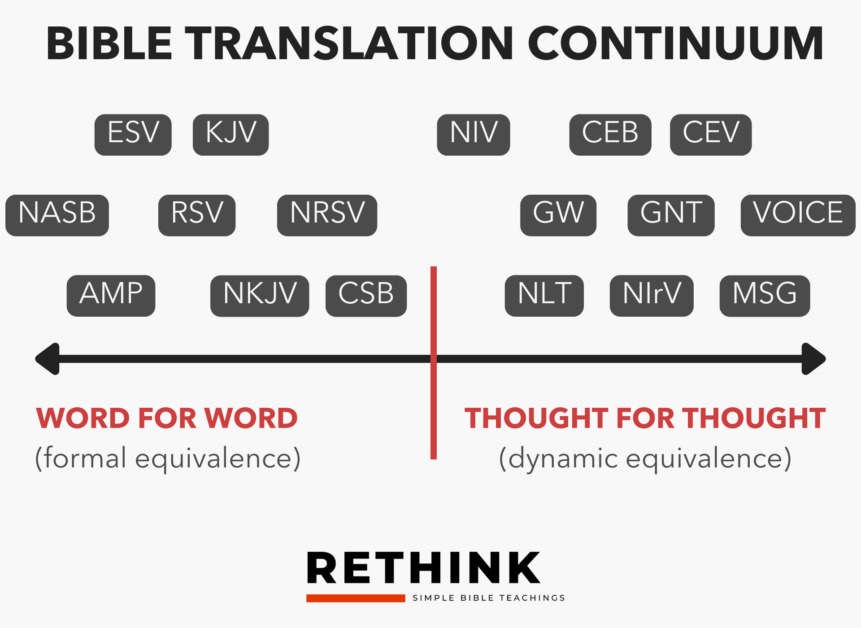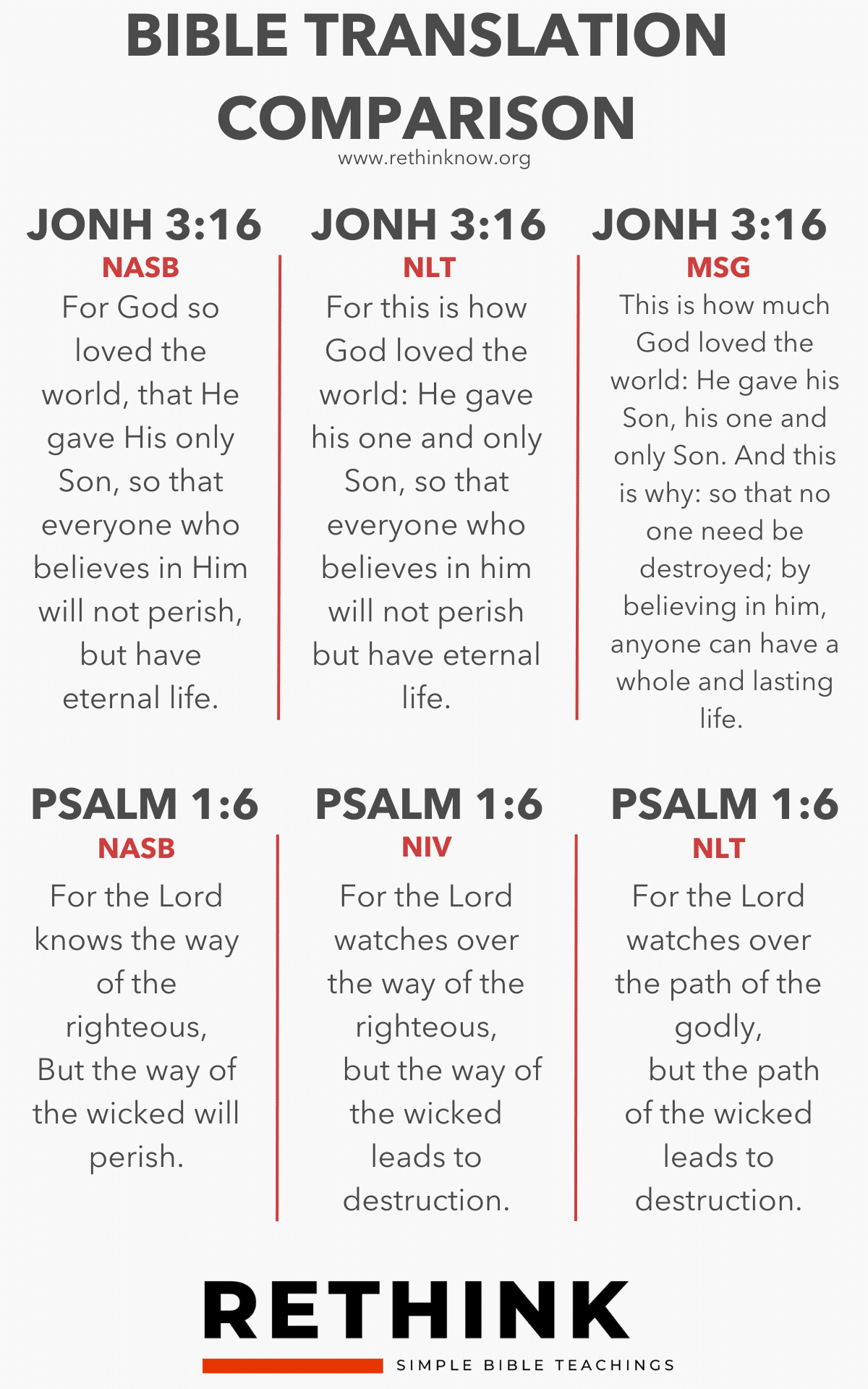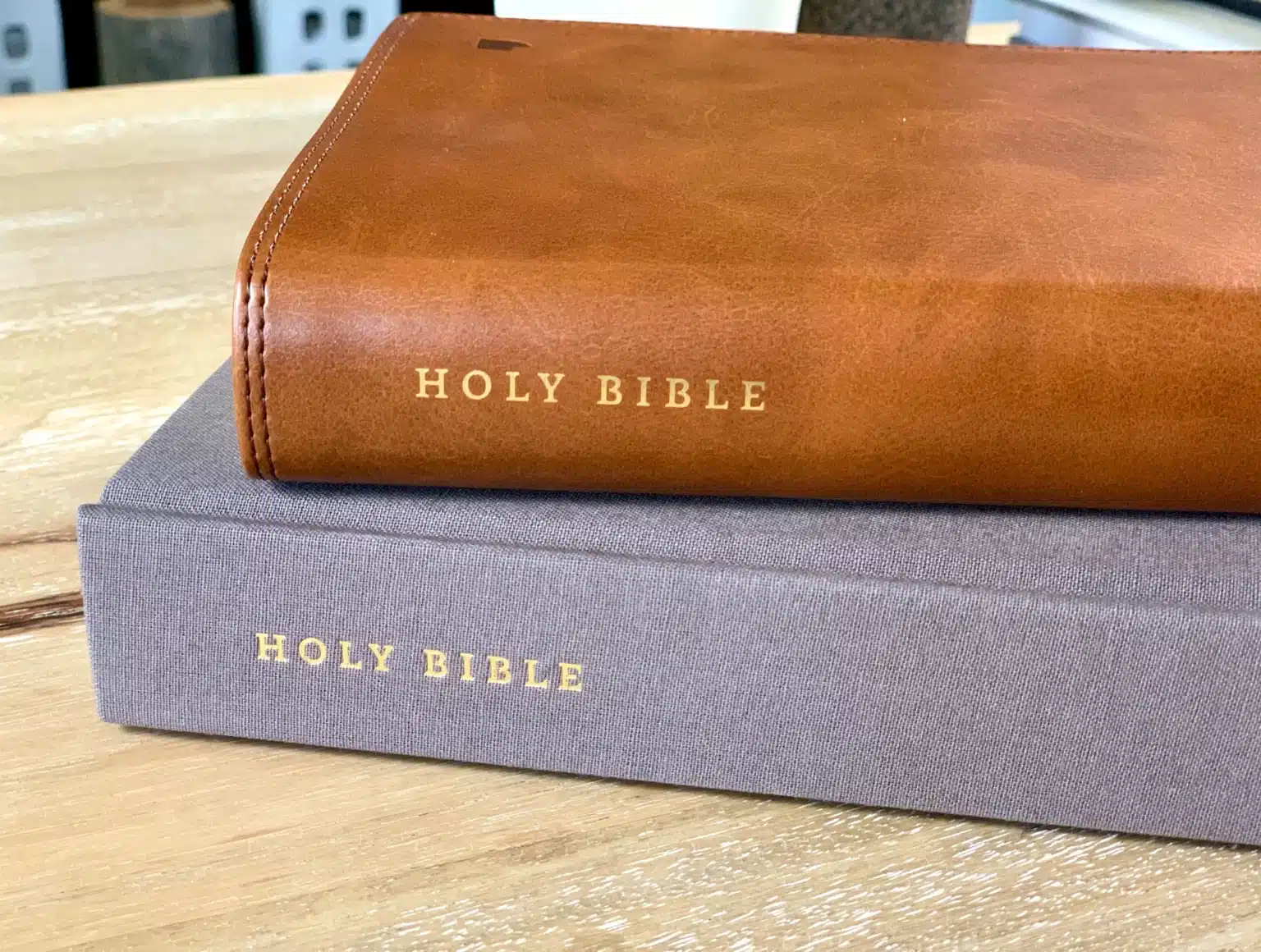There are a LOT of translations of the Bible, over 400 English translations alone. That’s more options than you have in the toothpaste aisle! With so many options it can be hard to know which is the best Bible translation. And this leaves many people wondering what is the best and most accurate Bible translation.
I want to provide some clarity on Bible translations and help you choose the best one for you. In this blog post we are going to look at what exactly is a translation and why we have so many. And then I’ll give you some recommendations for the best translations to use.
Table of Contents
What Is A Bible Translation?
Most of us view the Bible as a book. But it’s not really a book, rather it’s a collection of 66 books and literary works. It was written by many authors over thousands of years in several different ancient languages. The Bible you read today is a translation from the original language into a modern language.
Now, I’m not going to go into all the details of manuscripts, textual reliability, and all that other stuff. It gets pretty technical. But if you are interested in learning about that check out this article: How We Got The Bible (from bible.org)
On the surface translating might seem relatively straightforward. But it gets complicated because the Bible was written in what is now dead (unused) languages. Often the words in the ancient languages (Greek, Hebrew, and Aramaic) don’t have a one-for-one equivalent in modern languages.
For example, love in the English language is used very broadly. I love my wife. I love ice cream. I love football. I love my son. I love my friends. I love traveling. I do in fact love all those things, but I love them all very differently. So, the word love gets twisted and shoved to fill multiple meanings.
Now, here’s where it gets complicated. The New Testament was written primarily in Greek and in the Greek language, there are many words for love. Here are a few: Eros (sexual), Storge (affection), Philia (friendship), and Agape (unconditional). If you were to just translate the word love from ancient Greek to modern English there’s no one-for-one equivalent.
This leads us to two broad categories most translations fall into: Formal Equivalence (word-for-word translation) and Dynamic Equivalence (thought-for-thought translation).
Both have their strengths and weaknesses. Formal versions risk miscommunicating the original meaning; think back to the example of love, by seeking a literal word. Yet they can be helpful for studying the formal features of the text.
Dynamic versions more clearly communicate the meaning of the text in modern language. Yet because they are more interpretive they run a much greater risk of misinterpretation.
These categories aren’t either/or. Most translations will fall on a spectrum from word for word to thought for thought. Here’s what this looks like:

This chart puts some of the most popular translations on a continuum so you can see where they fall. This is not an exact chart, but rather an overview to see which translations are more literal and which ones focus on the main ideas. The best Bible translation for you depends on what you are going to use it for. This chart will help you see what each translation is best suited for.
Really it comes down to what you are reading it for. A more literal translation can be useful when doing an in-depth study of a passage. Whereas most prefer an easier-to-read, thought for thought, translation when just reading more devotionally.
Before we dive into what the best Bible translations are, I want to show you how this looks side by side. Here are two different verses in multiple translations.

This graphic shows you the difference between Word for Word and Thought for Thought translations. Some of the wording might look a little different, but the overall message of the verse stays the same.
Hopefully, that helped you better understand what a translation is and how we got so many. Now I want to shift gears and look at what is the best Bible translation in 2024.
What Is The Best Bible Translation?
So, what is the best Bible version? Let’s take a look at some of the best options.
The Most Accurate Bible Translation: New American Standard Bible (NASB)
Most people assume that the best Bible translation is the one that’s the most accurate. And on the surface that makes sense, but in reality it’s not the right question.
Remember not every translation has the same approach. Some are word for word and others are thought-for-thought translations.
Therefore the most accurate Bible translation is subjective. But if you are looking for one of the best literal Bible translations I recommend the New American Standard Bible (NASB).
The NASB is one of the best Bible translations for people wanting an accurate word-for-word translation. It stays as close as possible to a literal reading of the original text.
Widely considered one of the most accurate Bible translations, this does come at the sacrifice of readability and comprehension. That’s because the NASB focuses on finding the closest word to translate and not what flows in the English language.
This can make it clunky to read, but a very good option when doing an inductive study on a passage or for those who prefer to read as close to the original language as possible.
Buy it here: New American Standard Bible
This isn’t the best Bible translation for most people. So I want to give you a few more options that I think are better for the average reader.
The Easiest Bible Translation To Read: New Living Translation (NLT)
The NLT is one of the easiest translations to read. It uses verbiage and language that is commonly used in modern day. It strikes a good balance between ease of reading and staying true to the original text.
While it is far from a literal, word for word translation, it does a great job communicating the main thought of the original author. This is a great option for someone that wants the Bible in a readable format, but still maintaining the integrity of the author’s original meaning.
Buy it here: New Living Translation Bible
The Middle Of The Road Bible Translation: New International Version (NIV)
The NIV is one of the most popular translations today and for good reason. It takes a kind of hybrid approach to translation and finds an optimal balance between readability and exactness.
This combination of these two methods creates a unique literary style that many like. And chances are if you attend a contemporary church they likely use the NIV.
The NIV is a great choice for someone who wants something between a word for word translation and a thought for thought translation.
The CSB is another good option in this category.
Buy it here: New International Version Bible
A Literal (but not too literal) Bible Translation: English Standard Version (ESV)
The ESV is my favorite translation, although I also enjoy reading the NLT. This translation leans more towards a literal translation, however not to the point of sacrificing too much readability.
This translation is written in modern English, however it’s done in a way that reminds readers of the KJV and RSV. It’s a little more of a formal writing than the previous two, so if you prefer that style this is a great option.
If you are looking for a modern literal translation that is a little easier to read than the NASB I would recommend the ESV.
Buy it here: English Standard Version Bible
A Different Perspective Translation: The Message (MSG)
The Message is not a Bible translation. It’s a paraphrase. The MSG doesn’t convey the words from the original author but rather the main idea. That’s important because the criticism it gets is because people confuse these two.
Thus when you read the MSG you will see drastically different words and phrases. It’s not a true translation, as the goal is to convey the tone and feel of the text rather than the text itself. This can be very useful when used with a more literal translation to help you see Scripture in a different light.
The Message is a great option to read alongside another translation. It can help you see Scripture in a new light. But when read by itself we can miss some of what the Bible is communicating.
Buy it here: The Message Bible
A word of caution…
There are an increasing number of paraphrased versions of the Bible. While I have found The Message to stay relatively close to the original meaning of Scripture, others do not. Some are simply bad translations, others are egregious in how they handle the text. These translations should always be read alongside a more literal translation to help us navigate what the Bible actually says.
A Translation To Avoid: King James Version (KJV)
I know this isn’t a popular opinion, but the KJV is not the best Bible translation for most people. I’ve received my fair share of emails about how I’m wrong and it’s the only “authorized” version and the most accurate translation, but that’s simply not true.
If you want you can email me and tell me I’m wrong, here you go: [email protected]
Now, I don’t think the KJV is bad or wrong. If you own a KJV and you love reading it, keep it. Many people grew up on it and it holds value. That’s fine. My argument isn’t that we should get rid of it, rather that there are better translations today.
I have two reasons I think you should look at other translations.
My first concern is the reliability of the translation. The KJV was originally written in 1611. The writers were certainly experts and were working with the best manuscripts they had at the time.
But in the centuries since, we’ve discovered much older (in translating older is better) manuscripts that most modern translations use. Particularly in their words in the New Testament, the manuscripts they were working with were relatively new (new is not as good). This means that today’s translations will have a more accurate understanding of the original texts.
While the KJV was undoubtedly the most accurate translation when released, by today’s standards, there’s much more accurate Bible translations available.
My second concern is the style of the translation; it’s in Old English. Our language is constantly evolving. New words are made and words can even change meaning over time.
The KJV is filled with archaic terms that can confuse modern readers. This doesn’t negate the accuracy of the KJV, the translators were simply translating into their language. But language changes over time and translations need to be kept up to date.
The majority of the New Testament was written in Koine Greek. It was a common everyday language of the day. Simple and easy to understand. That’s how I believe we should translate the Bible today. But the KJV is a dated language. Many of the phrases and words are no longer in use today, thus making it very hard for most to understand.
Now, if you like the style of the KJV but want a more updated version of it, the New King James Versions (NKJV) is perfect for you. It reads reminiscent of the KJV but in a more modern context with the older manuscripts used in translation.
If you don’t care about the “thee” and “thous” I would recommend the ESV. It’s the modern equivalent of the KJV.
Buy it here: New King James Version Bible
So, What Bible Translation Should I Use?
So, now you’ve seen what some of the best options are for choosing a Bible translation. But which one should you choose? The simple answer is, the one you read.
There are so many great options out there; it comes down to which one you prefer. Go check them out; you can read several of them side by side and see which you prefer. Then go buy your favorite.
A great free option is the YouVersion (Bible App). It is one of the most popular apps and is on half a billion phones around the world. This app has just about every translation and 1000s of reading plans.
One final recommendation. If you are struggling to read and understand the Bible I highly recommend Mark Moore’s books Core 52 and Quest 52. These simple 15-minute daily readings will help you connect with God and understand the Bible better. They are INCREDIBLE. Plus there’s kids/teen versions as well!
You can buy them here:
- Core 52: A Fifteen-Minute Daily Guide to Build Your Bible IQ in a Year
- Quest 52: A Fifteen-Minute-a-Day Yearlong Pursuit of Jesus
- Quest 52 Student Edition: A Fifteen-Minute-a-Day Yearlong Pursuit of Jesus
- Core 52 Family Edition: Build Kids’ Bible Confidence in 10 Minutes a Day: A Daily Devotional
What is your favorite translation? What do you think is the best Bible translation?
- The Powerful Proverbs 27:17 Meaning (iron sharpens iron) - March 25, 2024
- What Is The Meaning Of James 1:17? (every good and perfect gift) - March 19, 2024
- Church, Your Hope Is Not In The Election. - March 19, 2024

